Sustainable nutrition security
Food is essential for the functioning of all living organisms. Food contains energy, which is harvested from sunlight via photosynthesis by plants and stored in their organic compounds. Non-photosynthesizing organisms, such as animals and human beings, depend on food for their energy. In addition to energy, food also provides other essential compounds such as the proteins, vitamins and micro-nutrients necessary for life. Livestock farmers decide to a large extent the mix of feed that animals consume, tailored to their requirements. In humans, the food choices made by consumers have a major effect on health and wellbeing, and the importance of a balanced diet is well-known.
Food security involves not only food availability but also food access and use. In other words, it goes beyond the production of sufficient food. This is illustrated by the fact that, while still working on the Hunger Challenge, we are simultaneously facing an obesity epidemic. Nutrition refers to the process involved from the choice and consumption of food up to its effects on health and well-being of individuals. The focus of this book, therefore, is not only on food but also on nutrition, hence the term nutrition security.
Apart from providing energy and nutrients for our basic functioning, food is also important in social life, rituals and celebrations. It forms a major component in all cultures and all structures of everyday human life, and plays a key role in the stability and development of societies. Our food supply is strongly linked to environmental issues. Crop production requires inputs like fresh water, fertilizer and pesticides to control weeds and pests. Animal production requires inputs such as fresh water, feed, vaccines to prevent diseases and medicines to cure diseased animals.
Growth of the world population and some major events in the history of (agricultural) technology
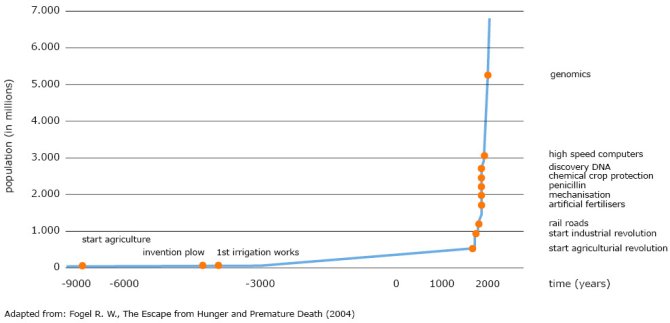
Agriculture is at the base of our food supply, but also yields biomass for other purposes like the production of bio-fuel. The total of food and non-food functions of biomass is often referred to as the bio-economy, and to achieve sustainable nutrition security, the food supply needs to be in balance with other functions of the bio-economy. This is not an issue of producing food or fuel but rather of producing food and fuel. Moreover, it is increasingly acknowledged that food production is only one of the many services provided by the ecosystem of planet earth. For instance, the ecosystem plays a role in protecting crops and animals from new emerging diseases.
Realising sustainable nutrition security is a central issue for the coming decades, containing a wide range of related topics. Many questions arise: How can we feed the world population in the future within the carrying capacity of our planet? What are the relations between food and health? How can we ensure sustainable food supply systems in different regions? How do we deal with climate change? How do we balance productivity and animal welfare? How do we share the benefits along the food supply chain? How do we integrate food production with other functions of the ecosystem? How do we implement innovations across the entire food supply system and how do we balance ecological and economic issues? How do we secure the safety of food? How do we ensure equity and equality when it comes to access to food? How do we allow for cultural varieties in food production and consumption now that the food system is homogenising? How do we balance power relations in food chains and networks so as to ensure access for all? This serves to illustrate that technological solutions alone will not lead to sustainable nutrition security, and that social, cultural and economic dimensions also need to be considered. A number of these questions are addressed in this book. Although not intended to fully cover the activities of Wageningen UR, our hope is that by combining a description of general strategy with practical examples we provide a good picture of the contribution Wageningen UR intends to make to the future of sustainable nutrition security.
Global food availability
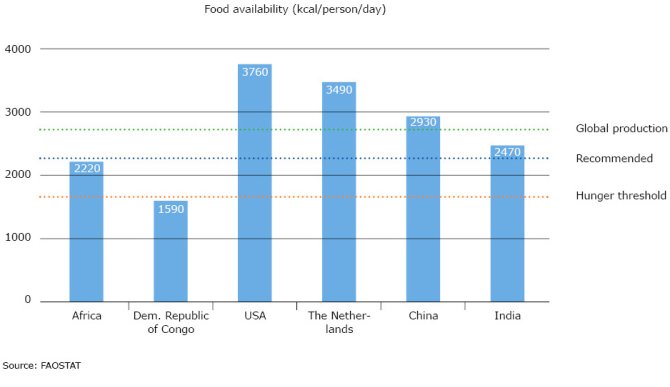
Food Production
From the very first beginning of agriculture, technological improvements and social innovations shifted offering a more effective way of collecting and producing food. Nonetheless, a recurrent question has been whether food production could keep pace with a growing global population. A major step was taken around 10,000 years ago when humans started to move from hunting and gathering to growing crops and keeping livestock. Over the last 150 years, major changes have taken place. Breakthrough technologies made it possible to produce more with less labour, enabling the world population to grow and enabling more and more people to work outside agriculture. During this period, agricultural production in the Netherlands increased by a factor of six to eight while labour productivity (i.e. production per fte) increased by a factor of more than 200. In addition, there have been major developments in processing and preservation which improved the efficiency of the food supply chain and increased its complexity.
At the end of the 18th century, Thomas Malthus warned for a population outgrowing the agricultural production capacity. He pointed out that while the population tends to grow on a logarithmic scale, food supply increases linearly at most, with the inevitable consequence that food supplies will run out. “The most enthusiastic speculator cannot suppose a greater increase than this,” Malthus wrote. Reality proved different, however, and productivity outstripped the population increase over the following century.
Nutrition refers to the process involved from the choice and consumption of food up to its effects on health and well-being of individuals
Almost hundred years later, the club of Rome commissioned the report ‘Limits of Growth’. Published in 1972, it concluded in a neo-Malthusian way that “If the present growth trends in world population, industrialisation, pollution, food production and resource depletion continues unchanged, the limits to growth on this planet will be reached sometime within the next one hundred years.”
Once again, however, food production grew faster than anticipated by the scenario builders. This increase of productivity was the direct result of major breakthroughs like the invention of fertilisers by Liebig and the principles of genetics discovered by Mendel. The Haber-Bosch process by which atmospheric nitrogen can be transferred to ammonia formed the basis for the fertilisers we know today. The invention of vaccines to protect livestock and the development of pesticides to control pests, diseases and weeds contributed to improved productivity by reducing losses.
Increase in consumption
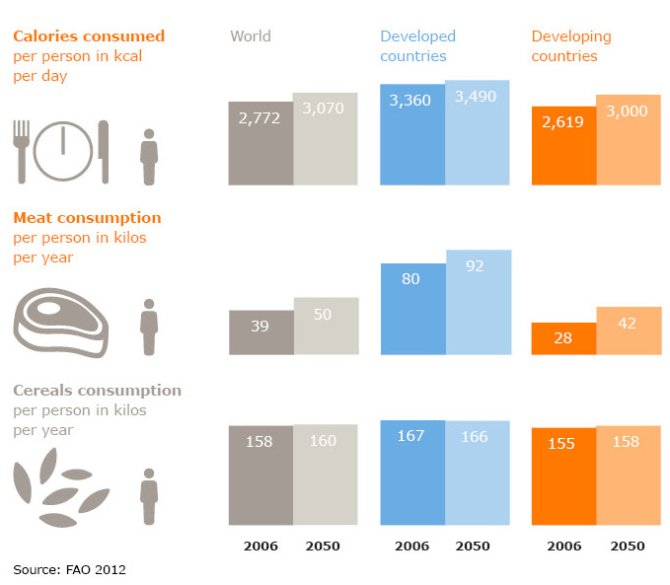
Mechanisation led to a considerable reduction of labour, and advanced nutrition for livestock improved feed conversion efficiency, especially in poultry, pigs, and dairy cattle. Effective institutions secured farmers’ access to capital for investment, appropriate information for productivity improvements and efficient markets in which to sell their produce. As result, more food is available per person now than a century ago.These developments may have a flipsite DDT, for example, was welcomed as a very effective insecticide, but turned out to have tremendously negative effects. After the later discoveries of less harmful but still effective compounds, the use of DDT was abandoned. An overuse of fertilisers in some parts of the world led to pollution and degradation of local biodiversity and contributed to the faster depletion of minerals such as phosphate. The use of antibiotics to protect livestock can lead to resistance in micro-organisms, which in turn threatens human health. Meanwhile, not all breakthroughs lived up to expectations. Growing public concern about the (potential) side effects of innovations was expressed through NGOs that aim for greater sustainability in food production.
The FAO considers Dietary Energy Supply (DES) to be a good indicator of food availability. DES reflects the food available for human consumption, expressed in kilocalories (kcal) per person per day. At the country level, DES is calculated as the food remaining for human use after the deduction of all non-food consumption such as exports, animal feed, industrial use, seed and wastage. Global DES increased almost linearly over recent decades, although there are considerable regional differences. In Sub Saharan Africa (excluding South Africa), the DES is substantially lower than the global average. Although the DES in Sub Sahara Africa increased over the last decade, this is not the case for regions with more than 35 percent undernourished people. Thus, while the overall food availability in this region tends to improve, the situation worsens in the most vulnerable areas.
DES only reflects energy, and does not take other aspects of nutrition into account. According to the FAO, almost two billion people suffer from some form of malnutrition. Vitamin and mineral deficiencies in children lead to stunted growth, blindness and compromised mental development, with iron-deficiency anaemia contributing to 20 percent of maternal deaths in Africa and Asia. Hungry, unhealthy people cannot be productive workers either, creating a vicious cycle of hunger and poverty. In contrast, overconsumption may also lead to problems. High energy intake and unbalanced diets may lead to chronic problems such as obesity, diabetes and hypertension. Again, it proves that nutrition security is far more complex than the production of food alone. It also concerns access to food, and the consumption of food that is safe and nutritious.
Growing demand for food
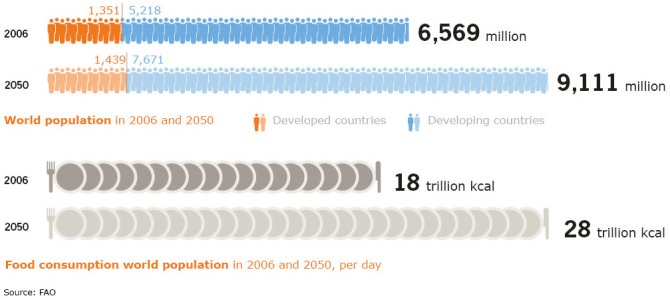
Food production does not solely involve land-based agri-production. The harvesting of seafood has been a major source of nutrition since ancient times and increased from 40 million tons in 1960 to 150 million tons today. Aquaculture is a booming agribusiness, increasing its production volume by 10 percent a year in addition to the limited seafood production capacity from fisheries. The share of seafood in global food production is expected to increase further.
Although nutrition security is much broader than food production, food security is a prime prerequisite for nutrition security. The FAO estimates that the world needs to increase its food production with 70 percent by 2050 in order to serve a global population of nine billion. Until now, the general picture has been that food production can keep pace with population growth, despite the existing hunger in several parts of the world which is mainly a problem of access. Agricultural productivity is very flexible, and man is creative in finding solutions for immediate threats. Agricultural production increased over the last century beyond expectations. Technological innovations resulted in discontinuities in productivity of wheat in Europe and the US in the 1950s and rice in Asia in the 1970s. But, within this historical perspective, what can we expect from our agricultural systems in the future?
Discontinuities wheat yield (UK & USA) and yield of paddy rice (Indonesia)
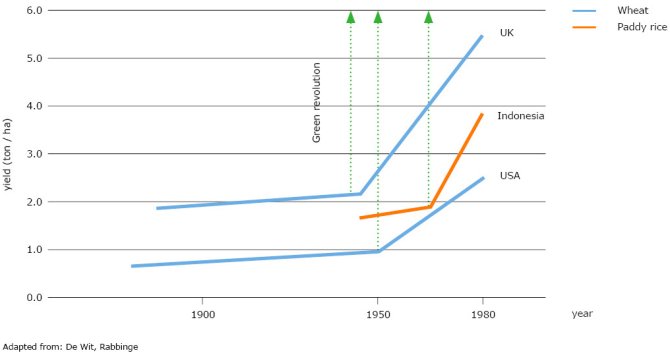
Sustainable intensification
Several pathways can lead to a higher availability of food. Land reclamation for agriculture is an obvious way to go, but has limited potential. In contrast, the amount of available land tends to decrease as a result of urbanisation, desertification and population growth. Extending the agricultural area has only limited potential therefore – a more feasible approach is to increase global production on the same agricultural area: Intensification of our production. The capacity to intensify production varies. In some regions, the actual yield approximates the theoretical maximum, leaving little room for improvement with current technologies, so fundamental breakthroughs would be needed. In other regions, however, much can be gained with existing technologies.
Although beneficial from a productivity point of view, the green revolutions also caused problems. While inputs such as fertilisers and pesticides can boost crop production, they also impact the local environment, contribute to climate change and depend on nonrenewable resources of minerals or fossil energy. Fertilisers require much fossil energy for their production and affect the natural environment, making it necessary to be efficient. In addition, resources like phosphate are limited, necessitating an efficient use and recycling wherever possible. The environmental impact of pesticides should be minimised by using pesticides that break down fast. In several situations, a biological control mechanism has effectively replaced the use of pesticides. Organic farming shows how much can be achieved by using the natural fertilisers and control mechanisms offered by nature. Nitrogen fixing legume plants and manure from animals illustrate how nutrients can be obtained from sources other than fertilisers. Therefore, although productivity is of major importance, the challenge ahead is to increase the sustainability of our food production systems. Not maximising yield but optimising it in balance with other ecosystems services should be the focus. And that can be achieved by innovative pathways, rooted in science and technology. This website gives examples of ways to contribute to these ambitious goals. It calls for a sustainable intensification of our production systems, which is far more than just a matter of higher production per hectare or per animal or higher feed efficiency.
The relationship between livestock and food security is often portrayed by the media in emotional terms such as ‘go vegetarian to save the planet’. It is not that simple. Livestock has positive impacts on ‘the planet’, not the least in the economy, with trade in live animals and animal products comprising 40 percent of the global value of agricultural output (FAO, 2009). Moreover, a billion poor people in Africa and Asia depend on livestock for their livelihoods. Animal feed production is increasingly competing for resources (land, water, and fertiliser) with human food and fuel production, urbanisation and nature. Combined with climate change (making production more volatile and harvests more insecure), this will increase feed prices and lead to a demand for livestock that can sustain productivity on diets with a lower nutrient density.
Our vision on the future of animal production is best reflected as ‘livestock farming with care’. This involves an integrated approach that can be captured in a set of four principles: Health (healthy and safe for animals and humans), customised (from the individual animals’ perspective), nuisance-free (from an environmental and societal perspective) and creditable (from a societal prospect). And this in turn requires research into the ‘best ecological means’ to reduce the ecological footprint and ‘best animal health means’ to prevent diseases (human and animal) and enhance animal welfare.
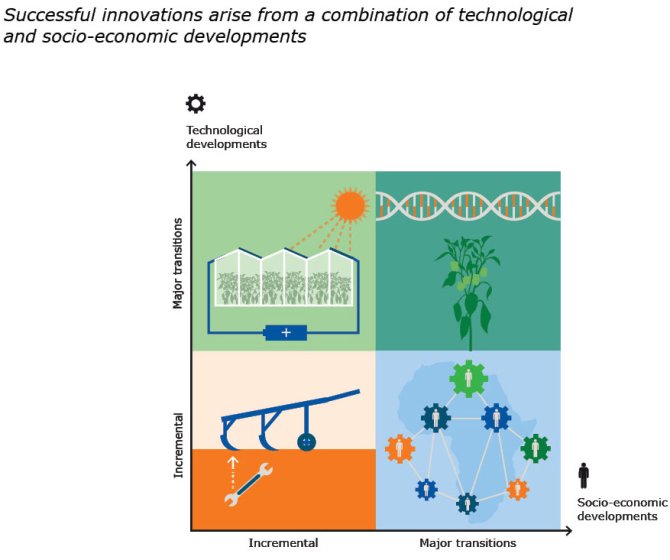
Food Systems
As argued, higher productivity by our agricultural systems is in itself insufficient for nutrition security. Food needs not only to be available, but also accessible and utilised to become effective. This is a matter of food supply systems, logistics and consumer behavior in addition to production. We need to address food supply systems rather than production systems if we are to nourish a future world. Apart from food production itself, many other factors determine the food system. In the first place, up to 40 percent of our food is lost in post-harvest phases. In developed countries, this is mainly due to food wasted by consumers and retail. In developing countries, this is often a result of ineffective harvesting and storage systems. Another important factor is the existence of food chains that determine the availability for consumers. This may be a simple chain for subsistence farmers and farmers with small cash crops. Or it may be complex chains for farmers who are serving the local or world market in fresh products such as vegetables, cereals and potatoes or processed products such as dough, milk and sugar. These chains often have an international dimension and involve many stakeholders.
Food supply systems are also integrated with other functions of the bio-economy. Biomass will increasingly be used for purposes beyond food, including biofuels and bio-materials. Biofuel is a relatively low-value use of biomass and requires vast amounts of resources, competing with the production of food and feed.

This application is therefore the source of much debate, especially where it concerns the direct use of food components for fuel, often referred to as firstgeneration biofuels. However, biofuels from non-food components may also jeopardise food production, as the production of the required biomass may compete with food production for scarce resources. The best way forward is to combine various applications, using all compounds of biomass in a smart way. This concept is referred to as bio-refinery, analogous topetrorefinery where all the components of crude oil are used in successive refinery steps. The non-food functions of the bio-economy are rapidly developing but highly dependent on technological breakthroughs.
Food chain
Food chain development, governance systems and co-innovation processes, however, need a strong scientific input from the social sciences. Complex trade and governance systems may easily lead to insecure markets, especially for commodities where national trade exceeds international international trade. Globally, for example, 650 megatons of rice is produced yearly, but only 10 percent is traded internationally. This is why food prices go up when shortages occur in some countries. In the recent past we had several peaks in prices that resulted in riots in countries where people spend more than half their income on food products. Particularly in developing countries, effective institutions are lacking to allow producers access to information, capital and markets for inputs and to sell their produce. The physical infrastructure to transport agricultural products to the market can also be limited. Investment in higher productivity will not lead to greater food security without addressing these other dimensions of food systems, including a stable political environment.
We are also witnessing a consumerist shift where decisions by consumers (and retailers) increasingly have consequences throughout the food system. Shifting consumer cultures, changing diets, demands for more sustainability in food and decisions on whether or not to accept particular food products, such as GMOs, cannot be ignored by the other actors in the supply chain. As this trend will only intensify in the future, decisions aimed at nutrition security need to actively take into account consumer viewpoints and their potential impact on the food systems.
The Wageningen Approach
As explained, food systems require concerted interventions in different domains. Interdisciplinarity is increasingly a guiding principle in education and research in our domain. This fits Wageningen UR perfectly and is referred to as the Wageningen Approach: Combining specialisation on the one hand with general knowledge on the other hand in our curricula (‘T-shaped’ skills). Wageningen therefore delivers academics who are experts in their own field while understanding experts in other areas (Education to see the bigger picture).
Wageningen UR is a major player in the domain of bio-economy. The developments in this domain are spectacular and offer new opportunities for potential innovations. Our understanding of biology and the functioning of ecosystems also serves as an inspiration not only for the design of novel food supply systems or systems to combat emerging diseases, but also for bringing about changes in consumer behaviour. Inspired by biology and based on the latest scientific insights, scientists at Wageningen UR contribute to the improvement of the earth’s ecosystem. Our understanding of socio-economic, cultural and political dynamics in a broad array of agro-food systems around the world serves as an inspiring resource for designing sustainable pathways to future food provision. Natural science approaches are therefore interlinked with social science approaches in these innovation pathways. We collaborate with others to realise our ambition and together open new pathways to solve the global challenges faced by us all. Joining forces will be the adage for the years to come, and Wageningen UR is dedicated to do so in order to meet the most challenging challenge of all: Sustainable nutrition security.